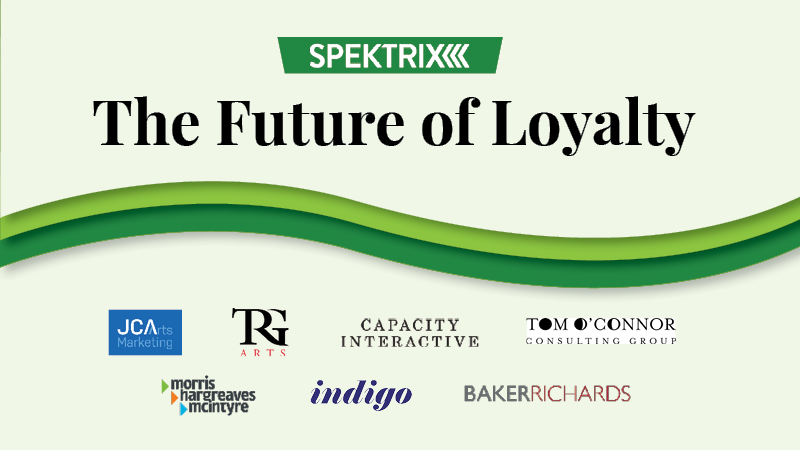
Earlier this month we hosted two events exploring the Future of Loyalty in 2023 and beyond. We’re hugely grateful to the expert partners who shared their thoughts with Spektrix users and other arts professionals.
In the UK: Baker Richards, Indigo Ltd, Morris Hargreaves McIntyre & TRG Arts
In the US: Capacity Interactive, JCA Arts Marketing, Tom O’Connor Consulting Group & TRG Arts
If you missed out, we've now published the full events online - helping you to explore what customer loyalty means for theatres, cultural venues and touring organizations in the post-pandemic world.
WATCH THE WEBINAR NOW
There was so much to say on the day that we didn't quite get through all of your questions. So we're grateful to Katy Raines from Indigo Ltd and Jennifer Sowinski Nemeth from JCA Arts Marketing, for answering a few of them here - bringing perspectives on audience loyalty from both sides of the Atlantic.
Question: With subscribers coming from so many different sources, would you suggest we launch flexible subscriptions, or any new loyalty model, with a segmented campaign, or more of a 'suck it and see' approach where we make the offer and see who bites?
Katy: I think it all depends on what you're actually launching. If you're going for something that's really flexible, starts with low frequency, and is applicable across all the work you do, then I'd be tempted to 'go big' and launch it to everyone at once.
This doesn't stop you 'picking off' segments/people who you think might be most interested, but gives it more awareness overall. If it's a more limited one-off, perhaps only on certain types of work, or aimed at people who are already coming quite often, then I think the segmented approach would be more appropriate.
Jennifer: Segmentation is always ideal so that you can target your messaging appropriately based on what is mostly likely to appeal to different groups. One segment of your audience is likely motivated by discounts – so flexible subscriptions may be attractive to them because they get a discount off of single ticket prices. Another segment of highly-loyal single ticket buyers may be more interested in making sure they see all of the performances they are interested in. Targeting that messaging appropriately can only help your efforts in selling a new offering.
That’s not to say that you shouldn’t offer flexible subscriptions as an option to anyone and everyone! But a segmented campaign will allow you to focus your efforts and use the appropriate messaging and method (direct mail, email, targeted ads, etc.) based on what each segment is most likely to respond to.
Question: How can you balance giving an excellent and engaging experience that make people want to come back with selling affordable tickets?
Katy: Affordable is not the same as good value, and if people feel they've had value for money, then they'll consider you again. So it's a good idea to understand their perceptions of the experience - what it delivered for them - AND their perceptions of value for money. Then you can use that language when talking to them again.
Jennifer: I hope these two things are not mutually exclusive!
It’s critical that all visitors to our organizations have an excellent experience, regardless of how much they paid for their ticket. If the question is around balancing the revenue required to provide a great experience with a low ticket price, then that’s where differentiated pricing is important. Offering multiple price points for every performance will help to maximize revenue by offering those who are willing to pay more the opportunity to do so, and maximize tickets sold by offering lower prices for those who can’t or won’t pay the top price.
And as far as the patron experience – those who paid the least for their tickets should feel just as welcome in your venue as those who paid the most. Our blog on Radical Pricing shares more of JCA Arts Marketing’s ideas on this topic.
Question: Do the panelists feel it is possible to effectively segment and target audiences without using non-transactional segmentation commonly used in the UK, such as Morris Hargreaves McIntyre's Culture Segments, the Audience Agency's Audience Spectrum or those offered by Baker Richards?
Katy: I don't think it's possible to have a segmentation without BOTH elements of: Behaviour (What people are doing) and Attitude (Why they are doing it).
But in my experience, it's always better to start with the 'what' and then find out the 'why' - because the 'what' gives you the best chance of spotting similar people when they pop up in your data. If you have to ask booker an attitudinal question in order to segment them, you'll only have the ability to segment a fraction of the audience, instead of the total audience.
Question: If younger audiences don't see theatre as for them, we've been in the habit of blaming the programming. But Nataki Garrett of Oregon Shakespeare Festival said recently that the problem has more to do with the invitation. Do the panelists agree that we've relied too heavily on older generations, and with Garrett's answer about where the problem lies?
Jennifer: I think, frankly, it’s a bit of both. Since the pandemic, audiences are looking for experiences where they feel like they know what to expect. They want to know in advance how an experience is going to make them feel. I suspect this plays a role in why classical music attendance hasn’t taken quite as big of a hit as theater attendance since the onset of the pandemic. Contemporary theater inherently has more unknown elements than other artforms.
To the asker’s point, though – it’s the role of marketers to lessen the perception of risk in buying tickets by giving the potential buyer insight into the unknowns. Inviting audiences in a way that helps them to understand what they can expect from their experience with the organization - from parking and picking up their ticket, down to the emotions that will arise during the performance. In this way, the invitation is absolutely critical, especially in bringing in new audience members, because fear of the unknown can be a primary barrier to attendance, especially post-pandemic.
So, any way we can break down that barrier will be a positive step.
Recording and slides from the Future of Patron Loyalty event in the US
Katy Raines is CEO and Founder of Indigo Ltd
Jennifer Sowinski Nemeth is Senior Consultant & Analyst for JCA Arts Marketing




 Bryony Bell
Bryony Bell